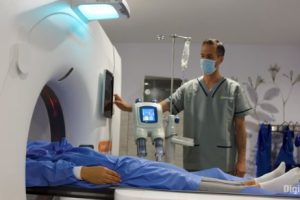Treatment of patients with motor disorders such as Parkinson’s disease could one day benefit from graphene, the highly conductive material which is expected to have electronics applications ranging from solar cells to semiconductors.
Researchers from the University of Trieste in Italy and the University of Cambridge’s Graphene Centre say it is possible to use graphene to make electrodes that can be implanted in the brain, which could potentially be used to restore sensory functions for amputee or paralysed patients, or for individuals with motor disorders such as Parkinson’s disease.
“We are just at the tip of the iceberg when it comes to the potential of graphene and related materials in bio-applications and medicine,” says Andrea Ferrari, director of the Cambridge Graphene Centre.
Graphene is a promising material for fabricating biomedical devices because of its high conductivity, flexibility, biocompatibility and stability within the body.
The important discovery the researchers in Cambridge have made is to demonstrate how graphene, which is a two-dimensional form of carbon, can be interfaced with neurons, or nerve cells, while maintaining the integrity of these vital cells.
The interaction between graphene and neurons, which has been investigated already, is very problematic because the signal to noise ratio from this interface can be very low.
What the Cambridge team has achieved is to develop methods of working with untreated graphene, which retains the material’s electrical conductivity, making it a significantly better electrode.
“For the first time we interfaced graphene to neurons directly,” said Professor Laura Ballerini of the University of Trieste in Italy. “We then tested the ability of neurons to generate electrical signals known to represent brain activities, and found that the neurons retained their neuronal signalling properties unaltered. This is the first functional study of neuronal synaptic activity using uncoated graphene based materials.”
According to Ferrari, the Cambridge Graphene Centre has been able to produce large quantities of pristine graphene material in solution, which has made it possible to prove the compatibility of the process with neuro-interfaces.
When it comes to applying the graphene to neuron signalling, the potential applications could be wide-ranging and significant in the area of brain science.
For example, surgeons believe that by creating an electronic interface between the brain and external systems it is possible to harness and control some of the brain’s functions.
“For instance, by measuring the brain’s electrical impulses, sensory functions can be recovered. This can be used to control robotic arms for amputee patients or any number of basic processes for paralysed patients – from speech to movement of objects in the world around them,” said the researchers.
This also means that by interfering with these electrical impulses, motor disorders, such as epilepsy or Parkinson’s disease, could start to be controlled.
This is possible because the electrodes can be embedded deep within the brain where they connect directly to neurons and transmit their electrical signals away from the body, allowing their meaning to be decoded.
For this to be achieved the electrodes need to be able to detect very small electrical signals, they must also be made from a material which is stable in the body and none invasive to the human tissue they measure.
Instead of traditional electrode materials such as tungsten or silicon, the Cambridge group used graphene which is both highly sensitive to electrical signals, due to its conductivity and it is stable within the body.
First experiments have been carried out in rat brain cell cultures and the researchers found that untreated graphene electrodes interfaced well with neurons.
By studying the neurons with electron microscopy and immunofluorescence the researchers found that they remained healthy, transmitting normal electric impulses and, importantly, none of the adverse reactions which lead to the damaging scar tissue were seen.
According to the researchers, “this is the first step towards using pristine graphene-based materials as an electrode for a neuro-interface.”
Professor Maurizio Prato from the University of Trieste says “the development and translation in neurology of graphene-based high-performance bio-devices requires the exploration of the interactions between graphene nano- and micro-sheets with the sophisticated signalling machinery of nerve cells. Our work is only a first step in that direction.”
The research, which was published in the journal ACS Nano, was funded by the Graphene Flagship, a European initiative which promotes a collaborative approach to research with an aim of helping to translate graphene out of the academic laboratory, through local industry and into society.
 Electronics Weekly Electronics Design & Components Tech News
Electronics Weekly Electronics Design & Components Tech News




